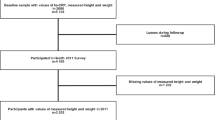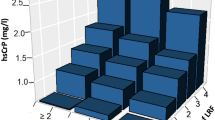Abstract
High sensitivity C-reactive protein (hs-CRP) is a marker of low-grade sustained inflammation. Omega-3 (n-3) fatty acids have anti-inflammatory properties and are associated with reduced cardiovascular disease (CVD) risk. The aim of this study was to investigate whether plasma n-3 fatty acid concentration is related to hs-CRP concentration. A total of 124 free-living adults, were divided into tertiles of plasma hs-CRP (<1.0, 1.0–3.0 and >3.0 mg/l). Body composition and anthropometric measurements were recorded. Hs-CRP was analysed using immunoassays and fatty acids were measured by gas chromatography. Plasma hs-CRP concentration was negatively correlated with total n-3 fatty acids (P=0.05), eicosapentaenoic acid (EPA; P=0.002) and docosapentaenoic acid (DPA; P=0.01). The highest hs-CRP tertile (>3.0 mg/l) had significantly lower concentrations of total n-3 fatty acids, EPA and DPA, when compared with the other tertiles (P<0.05). This study provides evidence that in healthy individuals, plasma n-3 fatty acid concentration is inversely related to hs-CRP concentration, a surrogate marker of CVD risk.
This is a preview of subscription content, access via your institution
Access options
Subscribe to this journal
Receive 12 print issues and online access
$259.00 per year
only $21.58 per issue
Buy this article
- Purchase on Springer Link
- Instant access to full article PDF
Prices may be subject to local taxes which are calculated during checkout

Similar content being viewed by others
References
Balk EM, Lichtenstein AH, Chung M, Kupelnick B, Chew P, Lau J (2006). Effects of omega-3 fatty acids on serum markers of cardiovascular disease risk: a systematic review. Atherosclerosis 189, 19–30.
Clearfield MB (2005). C-reactive protein: a new risk assessment tool for cardiovascular disease. J Am Osteopath Assoc 105, 409–416.
Endres S, Ghorbani R, Kelley VE, Georgilis K, Lonnemann G, van der Meer JW et al. (1989). The effect of dietary supplementation with n-3 polyunsaturated fatty acids on the synthesis of interleukin-1 and tumor necrosis factor by mononuclear cells. N Engl J Med 320, 265–271.
Geelen A, Brouwer IA, Schouten EG, Kluft C, Katan MB, Zock PL (2004). Intake of n-3 fatty acids from fish does not lower serum concentrations of C-reactive protein in healthy subjects. Eur J Clin Nutr 58, 1440–1442.
Kew S, Mesa MD, Tricon S, Buckley R, Minihane AM, Yaqoob P (2004). Effects of oils rich in eicosapentaenoic and docosahexaenoic acids on immune cell composition and function in healthy humans. Am J Clin Nutr 79, 674–681.
Kris-Etherton PM, Harris WS, Appel LJ (2002). Fish consumption, fish oil, omega-3 fatty acids, and cardiovascular disease. Circulation 106, 2747–2757.
Lepage G, Roy CC (1986). Direct transesterification of all classes of lipids in a one-step reaction. J Lipid Res 27, 114–120.
Madsen T, Christensen JH, Blom M, Schmidt EB (2003). The effect of dietary n-3 fatty acids on serum concentrations of C-reactive protein: a dose-response study. Br J Nutr 89, 517–522.
Pearson TA, Mensah GA, Alexander RW, Anderson JL, Cannon III RO, Criqui M et al. (2003). Markers of inflammation and cardiovascular disease: application to clinical and public health practice: A statement for healthcare professionals from the Centers for Disease Control and Prevention and the American Heart Association. Circulation 107, 499–511.
Pischon T, Hankinson SE, Hotamisligil GS, Rifai N, Willett WC, Rimm EB (2003). Habitual dietary intake of n-3 and n-6 fatty acids in relation to inflammatory markers among US men and women. Circulation 108, 155–160.
Acknowledgements
Statement of authorship: All authors contributed to the development of the protocol and were involved in the writing of the article. MAM analysed the data and wrote the article. All authors read and approved the final article.
Author information
Authors and Affiliations
Corresponding author
Rights and permissions
About this article
Cite this article
Micallef, M., Munro, I. & Garg, M. An inverse relationship between plasma n-3 fatty acids and C-reactive protein in healthy individuals. Eur J Clin Nutr 63, 1154–1156 (2009). https://doi.org/10.1038/ejcn.2009.20
Received:
Revised:
Accepted:
Published:
Issue Date:
DOI: https://doi.org/10.1038/ejcn.2009.20
Keywords
This article is cited by
-
Association of Lifelines Diet Score (LLDS) and metabolically unhealthy overweight/obesity phenotypes in women: a cross-sectional study
BMC Women's Health (2022)
-
Omega-3 polyunsaturated fatty acids status and cognitive function in young women
Lipids in Health and Disease (2019)
-
Review of Cardiometabolic Effects of Prescription Omega-3 Fatty Acids
Current Atherosclerosis Reports (2017)
-
Effects of 6-month eicosapentaenoic acid treatment on postprandial hyperglycemia, hyperlipidemia, insulin secretion ability, and concomitant endothelial dysfunction among newly-diagnosed impaired glucose metabolism patients with coronary artery disease. An open label, single blinded, prospective randomized controlled trial
Cardiovascular Diabetology (2016)
-
The associations of C-reactive protein with serum levels of polyunsaturated fatty acids and trans fatty acids among middle-aged men from three populations
The Journal of nutrition, health and aging (2016)



